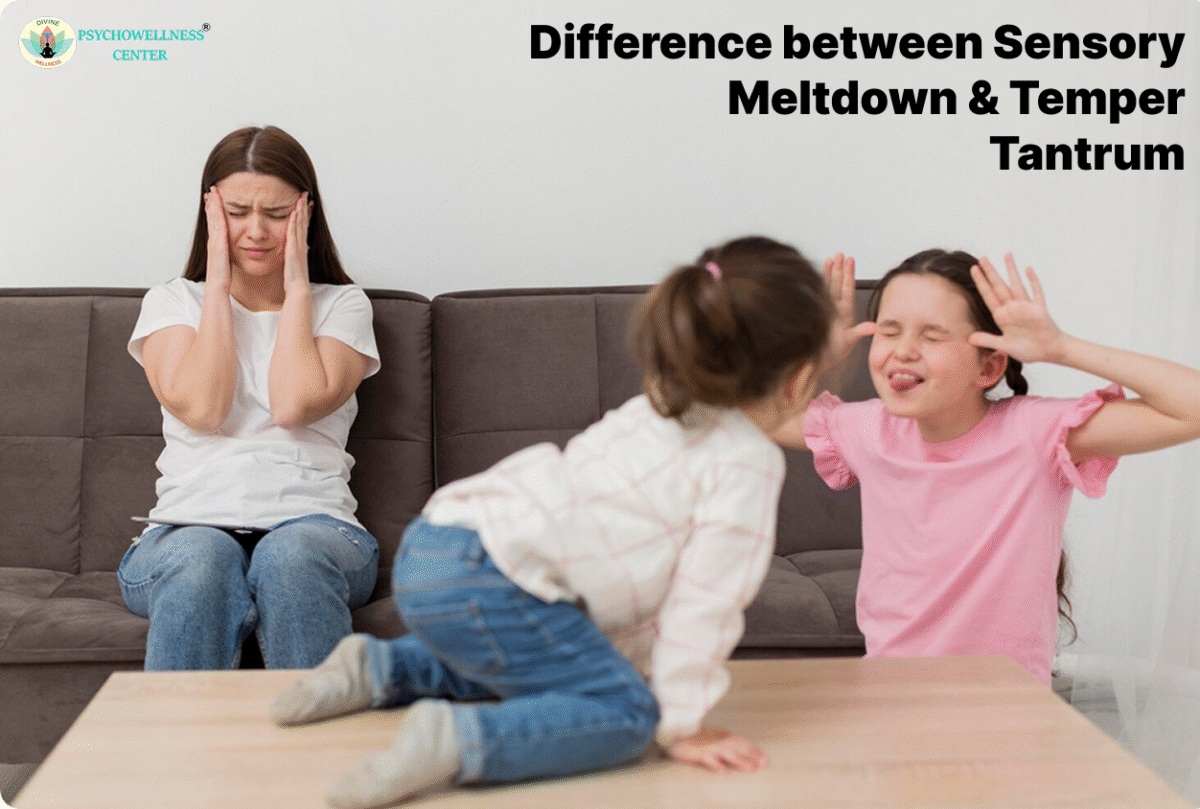Every parent, caregiver, or educator has likely faced a moment when a child suddenly screams, cries, kicks, or shuts down. While these behaviours can look similar on the surface, not all emotional outbursts are the same. Understanding the difference between a sensory meltdown and a temper tantrum is essential for providing appropriate support—especially when working with neurodivergent children, such as those with Autism Spectrum Disorder (ASD), ADHD, or Sensory Processing Disorder (SPD). Misinterpreting a meltdown as a tantrum (or vice versa) can lead to frustration, ineffective responses, and emotional distress for both the child and the adult. Let’s explore how to tell the difference—and what to do when these behaviours happen.
What is a Temper Tantrum?
A temper tantrum is a goal-driven emotional outburst that typically occurs when a child is frustrated, denied something they want, or trying to assert independence.
Common Characteristics:
Usually happens when the child wants attention, a toy, food, or another unmet desire.
- The child is often aware of their audience and may pause to check reactions.
- The behaviour tends to stop when the demand is met or when the child realises it won’t work.
- Includes behaviours like yelling, crying, stomping, or even hitting.
- Tantrums usually occur in developmentally typical children between 1.5 and 4 years old as part of learning emotional regulation.
Tantrums are closely tied to the development of executive function—the brain’s ability to manage impulses, emotions, and planning. These skills improve with age, guidance, and modelling.
What is a Sensory Meltdown?
A sensory meltdown is not manipulative or intentional—it is a neurological response to sensory overload. It occurs when the brain is overwhelmed by stimuli (e.g., lights, sounds, textures, smells) and cannot process or filter them effectively.
Common Characteristics:
Triggered by too much sensory input—e.g., loud environments, bright lights, itchy clothing, or crowded spaces.
- The child is not in control of the meltdown and cannot “just stop.”
- Unlike tantrums, there is no goal or desired outcome.
- Meltdowns often include shutdown behaviours (e.g., covering ears, lying on the floor, zoning out) or fight-or-flight responses (e.g., running away, screaming, aggression).
- Common in children with Autism, ADHD, or Sensory Processing Disorder, though neurotypical children can also experience meltdowns under extreme stress.
In meltdowns, the brain is in survival mode. The child is not trying to get attention—they are trying to escape discomfort or regulate overwhelming input.
Why This Difference Matters
Labelling a sensory meltdown as “bad behaviour” or punishing it as a tantrum can worsen emotional distress and cause shame, anxiety, or trauma. Children experiencing meltdowns are not being defiant—they are in crisis. On the other hand, giving in to a tantrum can reinforce manipulative behaviours if the child learns that outbursts lead to rewards. This can interfere with their emotional development and coping skills. Accurate understanding leads to compassionate, effective intervention—whether that’s teaching emotional regulation or providing sensory accommodations.
Supporting a Child Through a Tantrum
- Stay calm – Model emotional regulation.
- Set firm but loving boundaries – “I understand you’re upset, but we don’t hit.”
- Offer choices – Helps the child feel in control.
- Don’t reward the behaviour – Wait until calm to address the issue.
- Validate feelings – “It’s okay to feel angry, but it’s not okay to throw.”
Supporting a Child Through a Sensory Meltdown
- Remove or reduce stimuli – Dim lights, lower noise, or move to a quiet room.
- Don’t talk too much – Keep communication simple and soothing.
- Use grounding techniques – Weighted blankets, soft textures, deep pressure.
- Offer predictability – Visual schedules and clear transitions help.
- Allow recovery time – Don’t rush them to “snap out of it.”
Most importantly, never punish a meltdown—treat it the same way you would a panic attack or medical crisis. The brain is overstimulated, not misbehaving.
When to Seek Professional Help
If meltdowns or tantrums are frequent, intense, or impacting daily life, it may be time to consult a child psychologist, occupational therapist, or behavioural specialist. They can assess for underlying issues such as:
- Autism Spectrum Disorder (ASD)
- ADHD
- Sensory Processing Disorder
- Anxiety disorders
- Emotional regulation difficulties
Early support leads to better outcomes and helps children develop adaptive coping strategies that last into adulthood.
Conclusion: Compassion Over Correction
Understanding the difference between sensory meltdowns and temper tantrums allows parents, teachers, and caregivers to respond with empathy, not punishment. Both behaviours are expressions of unmet needs—either for regulation or connection—and deserve thoughtful, informed responses.
If you’re feeling overwhelmed or unsure how to support your child through emotional or sensory challenges, professional guidance can make a meaningful difference. Whether you’re wondering “Where can I find the best psychologist near me?” or looking for flexible online support options, help is available.
TalktoAngel, a leading online counselling platform, connects families with licensed child psychologists and therapists who specialise in emotional and behavioural issues. For those who prefer in-person care, the Psychowellness Centre, with branches in Janakpuri and Dwarka Sector-17, offers expert-led child therapy in a compassionate, kid-friendly environment. When we respond to children with understanding instead of judgment, we don’t just manage behaviour—we build trust, resilience, and emotional intelligence.
Contribution: Dr. R.K. Suri, Clinical Psychologist, and Ms. Mansi, Counselling Psychologist
References
- Baranek, G. T. (2002). Efficacy of sensory and motor interventions for children with autism. Journal of Autism and Developmental Disorders, 32(5), 397–422. https://doi.org/10.1023/A:1020541906063
- Potegal, M., & Davidson, R. J. (2003). Temper tantrums in young children: 1. Behavioural composition. Journal of Developmental and Behavioural Paediatrics, 24(3), 140–147. https://doi.org/10.1097/00004703-200306000-00002
- Miller, L. J., Anzalone, M. E., Lane, S. J., Cermak, S. A., & Osten, E. T. (2007). Concept evolution in sensory integration: A proposed nosology for diagnosis. American Journal of Occupational Therapy, 61(2), 135–140. https://doi.org/10.5014/ajot.61.2.135

